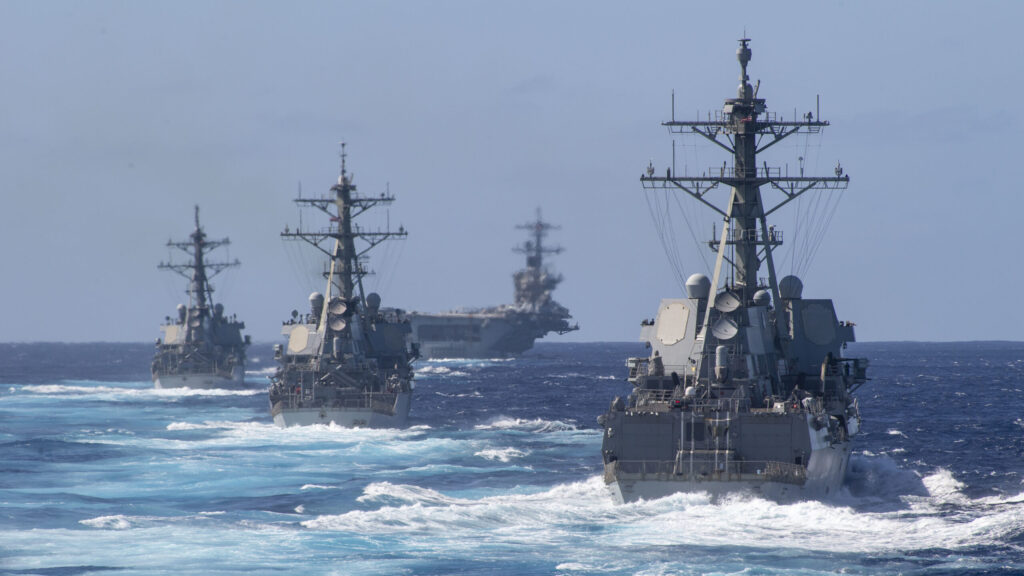The Theodore Roosevelt Carrier Strike Group transits the Pacific Ocean Jan. 25, 2020. (U.S. Navy photo by Mass Communication Specialist 2nd Class Jason Isaacs)
WASHINGTON — The US Navy’s fiscal year 2025 budget request seeks only six new battle force ships while divesting 10, a move that is sure to raise alarms and complaints in Congress, but one Navy leaders blame directly on the Fiscal Responsibility Act (FRA) of 2023.
“This year’s budget is an FRA-capped budget and we make hard choices, and in those hard choices we prioritize readiness to deploy and to operate our fleet,” Rear Adm. Ben Reynolds, deputy assistant secretary of the Navy for budget, told reporters last week. “We prioritize our people and the ability to respond in this decade of concern while taking some risk in future capabilities.”
The FRA, signed into law last June, suspended the country’s debt ceiling and allowed the government to borrow the money it needed to meet its obligations, preventing a global economic disaster that Treasury Secretary Janet Yellen was warning would come if the country defaulted. For the Pentagon, the FRA put in place an FY25 defense spending cap of roughly $895 billion.
The Navy and Marine Corps’ share of that topline under the newly-released budget request is $257.6 billion — $203.9 billion for the Navy and $53.7 billion for the Marines — a 0.7 percent increase over the previous year’s request of $255.8 billion. On the research and development side, the Navy’s FY25 request includes $25.7 billion and projects a declining R&D budget for the foreseeable future, coming down to roughly $22.7 billion in FY28.
For more coverage of the FY25 budget release, click here.
Navy Seeks To Divest Ships Early
The proposed ship buys include one Virginia-class submarine, two Arleigh Burke-class destroyers, one Constellation-class frigate, one San Antonio-class amphibious transport dock and the first Medium Landing Ship.
The 10 ships being retired early include two cruisers, one dock landing ship, four expeditionary fast transports, one expeditionary sea base and two littoral combat ships. The Navy routinely retires ships every year when they reach the end of their predetermined service lives, but the Navy must seek permission from lawmakers to “divest” of a warship, Pentagon lingo implying the ship would leave the fleet earlier than planned.
One way the Navy may try to forestall criticism is by pointing out that the shipbuilding budget is effectively flat — just slightly down to $32.4 billion from last year’s request of $32.8 billion. But that is unlikely to matter on Capitol Hill where divestments have proven to be a contentious topic between Navy officials and lawmakers every year. The Pentagon argues these ships are prohibitively expensive to maintain and that money would be better spent on advancing future technologies.
For many lawmakers though, increasing the Navy’s overall fleet size — for better or worse — has become a priority. Any drop in the ship count is viewed as a net negative and the combination of the Navy divesting of more ships than it is asking to buy will only act as lemon juice in the proverbial paper cut. The service’s ship count is constantly in flux depending on the annual schedule of retirements and commissioning ceremonies, but the fleet is currently at 292 ships — a far cry from the legal mandate set by Congress for 355.
Elsewhere in the shipbuilding budget, Navy Under Secretary Erik Raven, speaking alongside Reynolds, confirmed the service had updated its long-term shipbuilding plan to reach the 31 amphibious ship fleet that lawmakers previously mandated.
That may help serve as some sugar for the bitter shipbuilding pill on Capitol Hill, where a lack of investment into the amphibious fleet was a feature of numerous congressional hearings last year. Incensed by the lack of support for amphibious ships in the budget request, one senior Marine Corps officer called the Pentagon’s choice “unacceptable.” The leaders of the Navy and Marine Corps would subsequently take to the same public stage to make opposing arguments about the ships’ costs.
The officials said the fifth Ford-class aircraft carrier, CVN-82, which was previously planned for purchase in 2028, is now scheduled to be put under contract in 2030, a detail that will rankle the industrial base, which has been vocal in its concerns about delaying the buy beyond 2028. Despite the general enthusiasm from both the Navy and industry about the prospect of a “block buy” — inking a deal for two ships in a single contract — Reynolds said the FY25 budget does not finalize an acquisition strategy for CVN-82 and CVN-83.
Subs, Unmanned Systems And The Marines
On undersea warfare, the under secretary was enthusiastic with reporters about the “significant investment” the new budget makes, including $3.9 billion invested into the submarine industrial base in FY25 and a total of $11.1 billion across the five-year period known as the future years defense program.
The choice to only fund one Virginia-class submarine in FY25 is a cut from the previously planned two boats. Raven argued that despite the cut, the new budget maintains the other projected nine submarines as well as necessary advanced procurement funding to keep the submarine industrial base well positioned to support both the US Navy as well as the trilateral security pact AUKUS.
“We see [advanced procurement funding] as incredibly important in terms of supporting the supplier base to set ourselves up for the needed production rate both for Virginia-class… [and] we include support for Columbia class,” said Raven. “You will see in our upcoming shipbuilding plan… previous iterations of the shipbuilding plan included one Virginia-class in fiscal year 30 and 31. In the upcoming shipbuilding plan, you will see a consistent profile in the out-years of two Virginia-class per year.”
For the Marine Corps, in addition to the amphib, the inclusion of the first Medium Landing Ship (LSM) is a highlight. The service has spent the past four years refining its original Light Amphibious Warship concept into LSM, for which it released a request for proposals earlier this year. That ship’s core purpose is to help shuttle the Marine Littoral Regiments through environments like the first island chain in the Pacific.
The LSM, for which the budget requests $268 million, will “deploy tailored logistics, select power projection and strike capabilities in support of the Marine Littoral Regiment,” according to Navy budget highlight documents.
The new budget would procure the 30mm variant of the Amphibious Combat Vehicle, continue to invest in the Medium Range Intercept Capability’s launchers and missiles as well as sustain funding for the Ground/Air Task Oriented Radar.
In Marine Corps aviation, the service is seeking permission to start a two-year block buy of CH-53K heavy lift helicopters as well as a five-year multi-year procurement for associated engines.
For unmanned technologies, the service’s Large Unmanned Surface Vehicle program, which has several top prime contractors vying for a production contract, will delay its first procurement from 2025 to 2027, Reynolds said.
That program as well as the Extra Large Unmanned Undersea Vehicle, dubbed Orca, would see reduced funding in FY25 due to what Reynolds called “rephasing” into future budgets. In other words, the Navy will spend less money on the programs now, but plans to invest more heavily later.
“While some of the larger platforms like XLUUV and LUSV are being rephased, overall, we continue to see unmanned as the future of so many important naval capabilities and we are making those investments in this budget,” said Raven.





















Discussion about this post